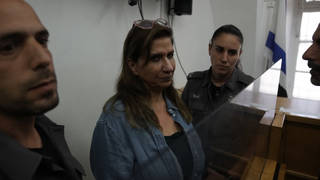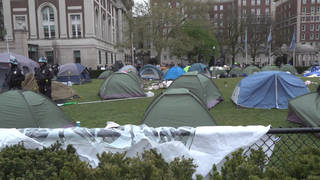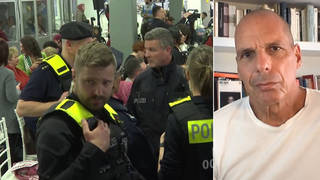
Related
This afternoon, Florida election officials plan to announce whether Vice President Al Gore or Vice President George W. Bush has won the 25 Electoral College votes of the state. The winner will become the next president of the United States. Before the recount, Bush led Gore by a margin of just 1,700 votes–the population size of a high school. [includes rush transcript]
But even if Bush gets Florida’s 25 electoral votes, Democrats suggested that they may pursue complaints about voting irregularities. Some Democrats in Palm Beach called for a new election in the county, saying the punch-card ballot was so confusing that people mistakenly voted for Patrick Buchanan, the Reform Party candidate, instead of Gore. The county is heavily Democrat but somehow ended up giving Buchanan 3,704 votes–nearly 2,700 more than Buchanan received in Florida’s 66 other counties.
Guests:
- Francisco Aruca, Host of Radio Progreso in Miami.
- Howard Simon, Executive Director of the ACLU in Florida.
- Randolph Scott-Mclauchlin, Director of the Social Justice Center at Pace Law School in New York. The organization yesterday filed a formal request with Attorney General Janet Reno requesting a formal investigation by the Justice Department into reported irregularities in Florida voting.
- Professor Barbara Scheffer, Professor of Civics and Government at Broward County Community College. She believes that due to an irregular ballot, the vote she intended for Gore went to Buchanan. She is pursuing legal action.
- Elaine Kligman, Palm Beach senior citizen who is concerned that many Gore supporters in her community accidentally voted for Buchanan due to irregular ballots.
Contact: ACLU Florida: 305-576 2336 / 2337
Transcript
AMY GOODMAN: This afternoon at around 5:00 p.m. Eastern time, Florida election officials may be announcing whether Vice President Al Gore or Governor George W. Bush has won the sixty-five electoral college votes of the state of Florida. The winner will become the next president of the United States.
Before the recount, Bush led Gore by a margin of just 1,700 votes, the size of a mere high school. But even if Bush gets Florida’s twenty-five electoral votes, Democrats suggest they may pursue complaints about voting irregularities. Some Democrats in Palm Beach called for a new election in the county, saying the punch card ballot was so confusing that people mistakenly voted for Patrick Buchanan, the Reform Party candidate, instead of Gore. The county is heavily Democrat, but somehow ended up giving Buchanan more than 3,700 votes, nearly 2,700 more than Buchanan received in Florida’s sixty-six other counties.
Voter fraud is not new to Florida. We turn to Francisco Aruca, host of Radio Progreso in Miami, to talk about what’s now happening in the state and about last year’s mayoral race in Dade County and what happened on the issue of voter fraud. Welcome to Democracy Now!, Francisco. Francisco?
Well, let’s turn to Howard Simon, Executive Director of the ACLU in Florida. The ACLU has received numerous complaints from voters since the elections. Howard Simon, can you lay out for us what has happened?
HOWARD SIMON: Well, first I want to say I don’t think, when we’re talking about Palm Beach, this is a situation of fraud. There has been a history and some recent unfortunate history of voter fraud in Miami-Dade County. I mean, the last mayoral election, for example, was thrown out because the absentee ballots were rife with fraud of the ballots of people who had been deceased and so on, and the apparent winner in the mayoral election was thrown out by the court and the incumbent was reinstated based on fraudulent ballots. But that’s not what we’re talking about in Palm Beach County.
What we’re talking about in Palm Beach County is the frustration of the will of the voters and the disenfranchising of voters because the ballot was unclear. It was a unique ballot in the state, in which candidates were placed side by side. And, for example, in order to vote for the candidate who was in the second row on the left side of the page, you had to punch the third hole. And it obviously confused lots of voters. 19,000 ballots were disqualified by people who punched one hole, realized they made a mistake, and instead of asking for a new ballot, punched a second hole, which, of course, would mean that their ballot would be disqualified.
In addition to that, 3,700 votes were cast for the person who had the second hole to punch, namely Pat Buchanan, which is clearly an anomaly. In the adjoining county, which is larger in population, considerably larger in population, Broward County, Buchanan got 769 votes. Clearly, a lot of people were confused as to whether to punch hole two or punch hole three, which means that the entire election in that county, the entire election in the state of Florida, and the results of the United States presidential election looks like it hinges on the fact that the ballot in Palm Beach County confused the voters.
AMY GOODMAN: Howard Simon, we’re also joined on the phone by Francisco Aruca of Radio Progreso in Miami. Give us a little history on voter fraud in Florida, Francisco Aruca.
FRANCISCO ARUCA: Well, the history here is not good at all. It is becoming now more important, since one of the irregularities that is being paid attention to here is precisely the absentee ballots. Your listeners should realize that although Dade County has a majority of Cuban voters, Gore won Dade County. That is because the blacks, white Americans and non-Cuban Hispanics voted for Gore in such a high percentage that they overcame the vote of the Cuban Americans. However, even though Gore won Dade County, he ended up losing in the absentee ballots by more than 7,000. That is attracting a lot of attention now that we’re all under the microscope, because of the importance of this issue.
And people, of course, realize that there is ample proof that there exists an organized machinery in Dade County that consciously has been using absentee ballots for fraud. In 1997, already an investigation took place that landed several people in jail, because even some dead persons ended up voting, by the way. That was discovered during the investigation. Several people landed in jail, including a commissioner. And a judge finally had to throw out the election for mayor of Miami in 1998 and actually cost the election to the one that supposedly had won it, Mayor Suarez, precisely because fraud in absentee ballots. So the fact that Gore won Dade County and now loses the absentee ballots by 7,000, of course, is being taken very much into account.
What will happen after that, we don’t know, because there is still very serious doubts as to whether these irregularities will lead to a deeper investigation. We don’t even know that. But, of course, a lot of attention is being paid to that issue. There is no doubt that the behavior of absentee ballots, given our past history, is something that should have people concerned.
AMY GOODMAN: We’re going to go now to two women who did cast ballots yesterday, two women who live in Palm Beach County. Professor Barbara Scheffer is with us, professor of civics and government at Broward County Community College. What happened yesterday?
BARBARA SCHEFFER: First of all, I’m in Palm Beach County, Palm Beach Community College. But aside from that, what occurred in relation to the voting process is I was actually told before I went into the booth that there may be some difficulty with the arrangement of the presidential candidates on the pages. And glanced down, looked at it, and with some fairly mighty effort managed to, I think — but that’s the operative word — I’m pretty unclear as to whether or not I actually voted for my choice of candidate.
And the net effect is that a lot of people are looking at this on television screens or seeing it from the standpoint of a flat image off of a Xerox machine. In fact, the presentation ahead of time in newspapers and so forth of that particular document was, again, on a flat surface. When you look at it three-dimensionally standing at, you know, at waist level, the entire perspective of the ballot takes on a completely different appearance.
I teach at a community college. I have had students come to me repeatedly throughout the last two days stating that they too had doubts. But they walked away. And one of the things that was also a general misunderstanding — including for myself, by the way — is that once I began voting, I felt like I could not walk away from that ballot and request a second one. You know, to me, that was discomforting. I obviously didn’t make the inquiry. A lot of other people did not, too.
I had one student that’s in my class who’s a nurse — who is a registered nurse who’s come back to the community college to get some further education, who said to me she knows she punched twice, because she tried to figure out a way to cancel the fact that she had cast her ballot for Buchanan, so she’s one of those 19,000 that Mr. Simon is talking about that really ended up with a double punch that has been disqualified.
Generally speaking, I think this thing needs to be redone. I certainly am willing, and I expect that I may end up participating in litigation that will turn into a request for a revote for those persons who did vote that day, at least for the presidential election.
There are other — and there are other, as Howard said, anomalies that exist up in this county. Pages were missing. In some instances, there were triple pages for president. The best way to characterize the ballot is it was kind of messy and very deceptive.
AMY GOODMAN: Elaine Kligman, you’re a resident of Palm Beach.
ELAINE KLIGMAN: Yes.
AMY GOODMAN: What happened with you yesterday?
ELAINE KLIGMAN: Well, just what this lady said. In fact, when we got the sample ballot, it looked completely different. Firstly, it was twice the size. Then it was in white with blue. And there were no punch holes in it, so that when we walked into the vote, it was completely different and very confusing. And believe me, none of us would have voted for Pat Buchanan, who was just on the Today Show and said, “These people would never have voted for me.” He just said it himself. So it is true that something was very wrong here and very confusing.
AMY GOODMAN: Well, actually, James Baker, the former Secretary of State, who was just dispatched by Bush to oversee the Republican monitoring team in Florida, told the Today Show that Palm Beach County voters’ rights were upheld. He said, “They did have a chance to have their voices heard. And let me tell you something else about that ballot. That ballot was posted as required by Florida law in newspapers and public places over the state of Florida, and not one complaint was received about that ballot, which, by the way, was approved by a Democrat who was elected.”
ELAINE KLIGMAN: We all know that. But as the lady before me said, it was a completely different look when you walked in there.
BARBARA SCHEFFER: The three-dimensional look, Amy, makes a whole world of difference. And by the way, I’m enjoying the fact that the Republicans are yelling and screaming about this, because I’m a registered Republican.
The bottom line is in a three-dimensional appearance, I would defy the majority of voters in this country to be able to figure out who they’d be voting for in relation to a series of arrows where holes appeared to be, you know, two tandem holes appeared to be next to the same names.
And in addition to that, lines that cut across at certain points where you did the punch hole, lots of people in this country, I’m sure, are used to using voter machines. That’s not what we’re talking about. We’re talking about a punch card. And again, I’m sure there’s other voters in this country that use that type of thing, too. The strip for the holes went down the middle between the names, instead of to the right, as required by state law. There’s a whole lot of things that are being brought into question.
It’s a question, too, in terms of who appeared in what order. As I understand it, under Florida state law, we’re supposed to have the order as follows: whoever gets the largest amount of vote in the primary goes first, second, etc., in a nice, orderly fashion. Well, that wasn’t the case here. You know, Mr. Gore was not second, and indeed should have been. So it goes way beyond the reach of meeting the requirements as far as pre-announcements or pre-publications.
AMY GOODMAN: I just want to understand something. You have a lawsuit in a Florida county, Palm Beach County, where more than 19,000 ballots have been disqualified. Howard Simon, how were they disqualified?
HOWARD SIMON: Well, they were disqualified by the fact that people realized they made a mistake. And when you realize you make a mistake, what you have to do — and I acknowledge it takes some courage to do so — you have to say that your ballot is spoiled, and you have to request another ballot. But instead of doing that, people mistakenly simply punched another hole. Well, you can’t punch two holes in an election for — in any election. If you vote for two candidates in an election, your ballot is going to be canceled. So that’s why 19,000 ballots were disqualified, because people had voted for more than one candidate.
But I want to say something about this. You know, it is true that this ballot in Palm Beach County was developed by a Democratic county clerk. It is true, I think, that the system is that when the clerk develops the ballot, she has to submit it to the two parties, and the two parties approve the ballot. And that’s how it got on the ballot.
But, you know, the parties have — the political parties have their own interests involved in this thing. But the concern that we have and the litigation that we are considering now and the discussions that we have with people is a discussion on behalf of the rights of the voters. The voters have a right to a clear ballot so that they can translate their intent into — and implement their intent in an election, regardless of whatever the political parties approve or whatever the political parties may think is a clear ballot.
In this particular case, the political parties may have approved a ballot that clearly — and I think the figures now after the election show it —- has frustrated the will of the voters and clearly confused lots of voters. 19,000 disqualified ballots are all out of proportion to the number of disqualified. It’s many more disqualified ballots than in Miami-Dade County, which is far more populous. I think Miami-Dade County had 10,000 disqualified voters. And here in a nearby county, much smaller in population, has nineteen disqualified voters. And people who did not punch twice -—
AMY GOODMAN: 19,000?
HOWARD SIMON: 19,000, right. So, you know, the parties and the clerk may have approved something, but what they approved disenfranchised voters from the most fundamental right that an American citizen can have, and that is the ability to participate in an election, because the voters were given a ballot that a lot of people did not understand and was not — and is not clear to many people.
AMY GOODMAN: And this is the only ballot like this in the state of Florida, is that right?
HOWARD SIMON: The only county that —- in every other county, the candidates are all listed on one column and with the holes to punch in the middle, or in some counties, where I live in Miami-Dade County, all the candidates are listed along the left side, and the same candidates in Spanish are listed along the right side of the page, with the holes in the middle. Palm Beach is the only county in the state in which candidates were listed both on the left and on the right. And as I said, most importantly, if you wanted to vote for the candidate in the second row, you had to punch the third hole. And that obviously confused -—
AMY GOODMAN: Howard Simon, how many complaints have you gotten at the American Civil Liberties Union in Florida?
HOWARD SIMON: Oh, I would say, more or less, between the complaints that’ve come directly to us and directly to our lawyers in their offices, I would say more than a hundred.
AMY GOODMAN: Randolph Scott-McLauchlin also joins us, Director of the Social Justice Center at Pace Law School in New York. Mr. Scott-McLauchlin, your group yesterday filed a formal request with Attorney General Janet Reno asking for a formal investigation by the Justice Department. Why?
RANDOLPH SCOTT-McLAUCHLIN: Well, we think that there are serious allegations here of irregularities. And we learned this morning that, as we’ve been told, that 19,000 voters were disqualified in Palm Beach County. Not only is there a substantial Jewish population there, there’s also a sizable African American population. And under the Voting Rights Act, the Attorney General is empowered to ensure and protect the rights of African American and other language-minority voters. And we believe there’s 19,000 people had their votes disqualified, their ballots, certainly something is wrong in Palm Beach County that deserves and warrants an investigation by the Attorney General.
But let me just say this: not only is the Attorney General empowered to operate under the Voting Rights Act, but lawyers and civil rights groups are also empowered to go straight to federal court to stop this election from going forward. And we are today reaching out to various civil rights groups across the country to call on all of us to join in an effort to make sure that the electoral process is free and fair and free from discrimination.
See, we want to pull this out of the hands of the traditional, you know, party officials, the Democrats and the Republicans, because this is not really about them. This is really about the voters, and not just the minority voters, but as the gentleman from the ACLU said, it’s about the integrity of this process. And if a candidate is elected under this cloud, he or she — he will not be able to govern with the will of the people behind him.
AMY GOODMAN: Now, I understand the Attorney General, at least at this point, is saying that she will leave it to Florida, to the recount, and to do their own investigation.
RANDOLPH SCOTT-McLAUCHLIN: Well, the problem with that is — and I’m waiting to hear her tell me that, because the problem with that is this is not just about recounting ballots. It’s 19,000 ballots were declared invalid. And we have to ask: how many of those ballots were in predominantly African American districts? That raises the specter of a Voting Rights Act violation.
Now, let’s be straightforward. I mean, I understand Ms. Reno’s backing up at this point. That’s understandable. She’s letting the state officials do their thing first. But once these requests have been made — and they’ve been made by my organization, by the NAACP and other groups — you know, once the Florida process has come to an end, which may be by the end of the day, she has to have an investigation or at least an oversight of that. And if she won’t, then there are other avenues that voters can take in Florida.
AMY GOODMAN: It is interesting to look at the vote for Buchanan. I understand in Palm Beach County, it’s something like three times the state average. And yet, Palm Beach County, well, how would you describe it in terms of its political persuasions? Let’s put that question to Palm Beach County Community College Professor Barbara Scheffer.
BARBARA SCHEFFER: I’m sorry, I’m not sure I understand —
AMY GOODMAN: The question of support for Buchanan in your area.
BARBARA SCHEFFER: I think basically, from the understanding, that Palm Beach County has, historically of all of the counties in Florida, been extremely strong in Democratic support, that when I look at the results and the total and tallies throughout the state, it’s a complete aberration. And I think, you know, again, it’s been mentioned earlier that Mr. Buchanan himself, Candidate Buchanan acknowledged that, which is rather telling as far as what he might have expected to receive from this county. An absolute, total aberration.
AMY GOODMAN: Randolph Scott-McLauchlin, do you think there could be a revote in Palm Beach County? Is that at all possible?
RANDOLPH SCOTT-McLAUCHLIN: I think this is a highly unusual situation. Though the parties are saying we’re not in a constitutional crisis, we surely are, because here’s the question: if it’s true that there were irregularities and maybe even deliberate misconduct — we don’t know that yet — in this county, what’s the remedy? How do you fix the problem? Well, one way is to declare that Palm Beach voters, their votes are completely invalid. We’re not going to do anything about it at all. That stinks.
But what’s the other option? To rerun the election in Palm Beach County, where there are irregularities proven, because, see, normally when you have irregularities in an election contest, the races aren’t that close. So the irregularities — let’s say there were — won’t make a difference in terms of whether or not X candidate should be elected or Y? But here, you’ve got 19,000 people. And the vote differential now, I’m told, last count was 900 votes. Certainly if something had been done properly in Palm Beach County, we wouldn’t’ve had that many voters confused and maybe even misled. So, yes, the remedy would be to have that rerun.
Now, what if we declare that Florida’s votes, all of the votes in Florida, because of the cloud in Palm Beach County, cannot be counted? Well, then we throw the election into the House of Representatives, which is not a good thing, given the state — you know, given the way that the House is controlled by one party.
So I think the only realistic fair option is to rerun that presidential election in Palm Beach County, and let’s see how the vote comes out this time.
AMY GOODMAN: Well, on that note, I want to thank you all for being with us. Randolph Scott-McLauchlin with the Social Justice Center at Pace Law School in New York; Howard Simon, Executive Director of the American Civil Liberties Union in Florida. By the way, if people want to get in touch with you, Mr. Simon, where do they call?
HOWARD SIMON: It’s (305) 576-2336 or -2337.
AMY GOODMAN: That’s (305) 576-2336, the American Civil Liberties Union of Florida; as well as Professor Barbara Scheffer of Palm Beach County Community College; and Elaine Kligman, a Palm Beach senior citizen concerned about how the vote was done in her community.












Media Options